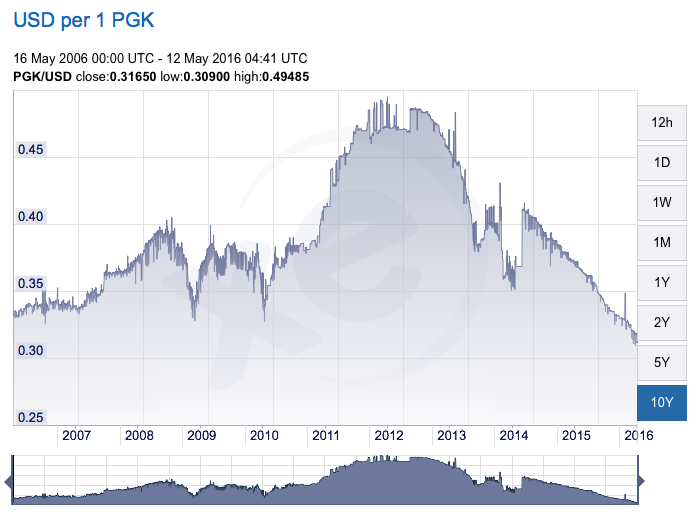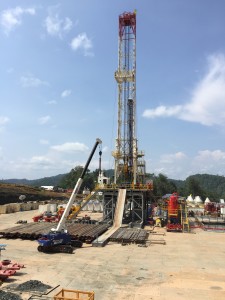The kina has fallen in value this year, but Papua New Guinea’s dependence on commodity exports means that it can be expected to fall further, says Rohan Fox, Lecturer and Research Fellow at the University of Papua New Guinea’s Division of Economics. He tells Business Advantage PNG that the country faces a difficult task managing the impact of sharp fluctuations in commodity prices.

UPNG’s Rohan Fox
Fox says this year the kina has depreciated, in some cases further than its competitors. But he believes the trend should continue.
‘It would make sense that the kina continues to fall to rates well below what it was in 2014 because, since that time, commodity prices have sunk.
‘Based on the most recent World Bank figures, while PNG gets over 30 per cent of its GDP from resource rents, Australia only gets 7 per cent.
‘The kina should in fact fall further than the trends from other resource exporting economies.’
More competitive
Fox says that although the kina has been depreciating against the US dollar since 2014, and so has become more competitive, the currency has become progressively less competitive against its major trading partners, including Australia and Japan—although that trend is beginning to be reversed.
‘Other resource exporting nations, PNG’s competitors Australia and Malaysia have exchange rates with Japan over 10 per cent below what they were in 2014.’
‘It reached a trough in a period late August to September’, says Fox. ‘Since then, the trend has been different, we have seen a partial reversal in the loss of competitiveness, and recently, it seems that the exchange rate has almost reached the rate against the Japanese yen that it had before the introduction of the trading bands.’
Good news for exporters
Fox says this trend is good news for exporters. But he emphasises that this does not mean that the currency is back to a competitive level.
‘For example, other resource exporting nations, PNG’s competitors Australia and Malaysia, have exchange rates with Japan over 10 per cent below what they were in 2014.’
‘Inflation averages around 5-6 per cent in PNG while it is more like 0-3 per cent in its major trading partners.’
Fox says estimates of the Real Effective Exchange Rate, which takes into account the effect of inflation, show that the kina should be around 40 per cent lower than its level at the end of 2014 (when it was 0.38 against the US dollar).
‘A lot of the problems associated with Dutch disease exist in PNG.’
‘Accounting for inflation differences is important because these reflect the differences in costs between countries. For example, inflation averages around 5-6 per cent in PNG while it is more like 0-3 per cent in its major trading partners.
‘This means that every year, even if exchange rates were kept exactly the same, PNG’s produce would become some 3 per cent more expensive than its major trading partners. Lowering the PNG exchange rate by 3 per cent per annum would correct for this.’
Dutch disease
Fox says PNG is vulnerable to “Dutch Disease”: the economic phenomenon whereby a resource rich nation finds that commodity price rises distort the rest of its economy, leaving it vulnerable when commodity prices fall.
‘One way to counter any adverse effects associated with volatility is to run ‘a well run Sovereign Wealth Fund.’

Ten-year view of the PNG kina value against the US dollar, May 2006 to May 2016. Source: xe.com
A lot of the problems associated with Dutch disease exist in PNG—an exchange rate that is boosted by demand for resources which reduces the competitiveness of important export growth sectors like agriculture and tourism. And due to the money involved, the resources sector disproportionately attracts scarce skilled human resources, making it difficult for other industries to retain talent.
‘A high exchange rate also affects investment flows. It makes it more expensive to invest in PNG relative to other countries, and it makes it cheaper to buy a house in Cairns or send one’s children to an overseas school.’
Sovereign Wealth Fund

Resource projects are part of PNG’s future. Source: InterOil
Fox says it must be accepted that resource projects are an important part of PNG’s economic future. One way to counter any adverse effects associated with volatility is to run ‘a well run Sovereign Wealth Fund’, which, he says would do much to smooth the impacts of resource inflows in to the future.
‘The current design of the Sovereign Wealth Fund has some major problems, and the history in PNG is that such funds can be undermined. This was the case with their earlier, initially very successful, Mineral Resource Stabilisation Fund.
Fox says PNG should also pursue other initiatives. ‘Much of the literature on Dutch disease/resource curse suggests that poor-results from resource wealth result from poor institutions.
‘Floated exchange rates can be volatile, especially for a country that relies so heavily on resource exports.’
‘Strengthening institutions, (perhaps through things like transparency initiatives) could help, monitoring organisations like the Ombudsman Commission and Auditor-General. Good policies are also critical.’
Trading band
Floated exchange rates can be volatile, especially for a country that relies so heavily on resource exports, says Fox. He believes this provides some justification for managing the exchange rate, as the Bank of Papua New Guinea is doing, rather than allowing it to float completely freely.
‘An even better policy would have been to increase competition in the foreign exchange market by allowing more banks in.’
‘The good aspect of a trading band is that it limits the [short-term] volatility in the exchange rate and allows businesses and consumers to adjust to new conditions. However, over an extended period, a misaligned exchange rate suffocates the economy.
‘In theory, I would support the idea of a trading band, though for it to be used it should have been based around the market rate, rather than the inter-bank mid-rate. The [central] bank could have achieved its stated objective of reducing bank profiteering.
‘An even better policy would have been to increase competition in the foreign exchange market by allowing more banks in, or at least more foreign exchange dealers. The challenge with any fixed rate is that it doesn’t deal easily with changes in trading patterns, changes in inflation rates, or changes in broader markets.’








Speak Your Mind